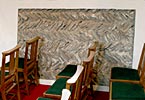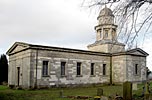For this church:    |
West Markham (Markham Clinton) All SaintsHistory
Although no accurate date can be given for the founding of All Saints’ church, experts consider there is a sufficient core in the structure to authenticate its probable Saxon origins. Indeed, in recent years, shards of Roman pottery were found in the floor by the altar. The earliest records of the village itself are to be found in Domesday Book of 1086, though there is no record of a church or priest. William the Conqueror allocated lands to Roger de Busli who established his castle at Tickhill (South Yorkshire). Included in his great estates was West Markham. Over the centuries the village has also been known as Parva Markham and Little Markham. Thoroton records an agreement between the church of West Markham and the chapel of Tuxford (1189), relating to tithes for a portion of land. The men were to take offerings of calves, foals, lambs, goats, and pigs (with eggs also at Easter) to West Markham, three times each year on All Saints Day, the Purification of St Mary, and at Easter. They were to be confessed there in Lent, receive communion there at Easter, and the bodies of their husbands and wives were to be buried there. At this time West Markham was the ‘Mother Church’, Tuxford having only a Chapel of Ease. Eleanor of Aquitaine, Queen of Henry II, founded a royal free chapel in the castle at Tickhill, endowing it with tithes of several Nottinghamshire churches, including West Markham (together with Harworth, Walesby, North Wheatley and East Markham). King John, when Earl of Mortain (1191-3) gave West Markham church, together with the chapels of Bevercotes, Kirton, Walesby, Haughton, Drayton, Gamston and Everton to the Archbishop and Chapter of Rouen, to whom they were appropriated and vicarages ordained in 1257. Bevercotes was a chapel of West Markham but others had no connection. The chapel at Bevercotes fell down in 1650. A translated copy of the agreement between the Chapter of Rouen and the Archbishop and Chapter of York is held by Nottinghamshire Archives. In the 1291 Taxatio of Pope Nicholas IV, West Markham church was valued at £8, with the vicarage valued at £8, and £6 13s 4d noted as a pension to the college and chapter of York Minster. Fifty years later, the Nonae Rolls record the total value of the church at only 22 marks (£13 6s 8d). In spite of the appropriation to Rouen, Robert Clarel, as a Warden of the Tickhill chapel, claimed the right of presentation by 1286. His successor Boniface de Saluzzo, claimed those churches formed a ‘Peculiar’ - thus exempt from the jurisdiction of the Archbishop of York. Although his claim failed, he retained advowsons until his death. Successive wardens were patrons until 1474, when Edward IV granted the advowsons to Lenton Priory. In 1503 Henry VII gave the patronage to Westminster Abbey. On 10th July 1552 the rectory of the free chapel of Tickhill, with all its advowsons, was given to the Earl of Shrewsbury, subsequently passing to his successors, the Dukes of Newcastle. In 1589 the churchwardens presented that the chancel was in decay in default of the Earl of Shrewesbury. In 1596 the churchwardens and one swornman presented that their vicar was a preacher and favourer of God's word; they have had two sermons by Mr Feilde and their vicar Mr Chapman; the vicar was not resident on his vicarage, nor did he give any relief to the poor; the chancel and the vicarage house were not in good repair. Two years later they were reporting that the glass windows in the chancel were decayed and the windows in general were out of repair, also that the lead that covered the bells was rolled up with the wind and the churchyard fence was broken; one Richard Knighte was presented for 'playing on his instrument in time of divine service'. In 1603 the chancel was apparently still ‘in decay’, the responsibility of the Earl of Shrewsbury, and by 1612 the churchwardens presented one Mr Tharland ‘for default of our chancel mending’. Clearly little happened over the next few years as by 1620 the chancel was reported as being ‘very ruinous’. Two years later, the minister, Robert Bruen, admonished his parishioners saying that notice had been given to some of his parishioners of the churchyard fence lying down, but no order has been taken to make it up; he asked Mr Malin to ‘awaken your dullness’ and cite John Fox and Jeffery Leighes for neglect. Problems with the state of the chancel continue to be reported throughout the 1620s and 1630s with the slates being defective in 1627 and the windows ‘out of repair’ in 1634. Four years later, the parish was taking matters into hand and it was reported that William Oldham and William Thorpe, farmers of the parsonage, were to repair two parts of the chancel, and the next year the churchyard was apparently ‘all sufficiently repaired’, 21s 8d having been laid out in repair of the church. Following the Civil War, by 1665 all seems to be reasonably well with the fabric of the building as it was stated that ‘our parish church is in very good repair, only we want some few utensils viz. a church Bible, and our churchyard is not fenced as well as we intend it, for which we desire time until the next visitation’. All is quiet until 1679 when the churchwardens reported that ‘a little part of the church wall did lately fall down, but we have begun to provide materials and workmen to repair it as speedily as may be’. In April 1684 the churchwardens’ presentment is unusually detailed: we have no hearse cloth, but the rest of the church utensils are generally very good and in safe hands, but not usually delivered from the old churchwarden to the new by bill indented; we have no poor man's box, nor locks upon our chest; our church is decently kept and in tolerable repair, except some drops in the leads and a few slates wanting on the porch, both which will speedily be repaired; our chancel was never paved since the steps were taken down in the “late times of Rebellion”; we have no terrier of our glebe, nor book of Homilies; our churchyard fences, formerly presented, are well amended; our minister has not read the statute against profane swearing and cursing, nor knows anything of it; our chancel floor is not paved, and it ought to be done; two parts by my Lord of Clare and one part by our minister. The following year it was reported that the church wall had fallen down on the north side. In 1718 the churchwardens stated that ‘church wants beautifying within; a hearse cloth, a hearse cloth and a poor man's box with three locks and keys wanted’. The following year a certificate was issued by the curate, churchwardens, and parishioners saying that that walls had been repaired with lime and hair inside and had been whitewashed inside; the roof, windows, pavement and seats had been repaired; the table of prohibited degrees of marriage, the Creed, the Lord's Prayer, the Ten Commandments, the King's Arms, and the Book of Homilies had been supplied; a poor man's box, basin for alms, hearse cloth and cushion had also all been supplied. In 1743 there were forty families in the parish, none of them dissenters. There was a free school for all the parish children but no almshouses. The vicar read the services each Sunday and administered the sacrament three times a year to between 30 and 40 of the 70 communicants. On 10th May 1824 a Faculty was granted by the Archbishop of York to the vicar and churchwardens of the parish of West Markham, to take down the parish church, known as All Saints, and to rebuild the same on a more convenient and elevated situation.
The Duke of Newcastle, at his own cost, built the new church, known as The Mausoleum some 800 yards away from the ‘Old Church’. The Mausoleum was built on the instructions of the fourth Duke, as a resting place for his Duchess, Georgiana Elizabeth, who died, aged 34, giving birth to twins in 1822. The Mausoleum was consecrated by the Archbishop of York in 1833, and it became the parish church. All Saints was allowed to fall into disrepair but, fortunately, not demolished. The new church had 210 sittings, and on census Sunday in 1851 65 attendees in the morning and twenty scholars. In 1912 there had been one baptism and six confirmations over the previous twelve months. There were 53 children in the school and 26 in the Sunday School. Records show that two baptisms and a wedding took place in the ‘Old Church’ and a number of burials took place in its churchyard. In 1945, the Duke of Newcastle sold his estates, and took no further interest in the family mausoleum, though some ten members of his family lie buried there. It was impossible for the local community to maintain two churches, and the old church was subject to a major restoration. In 1949, the Vicar, his churchwardens and a number of inhabitants, petitioned the Vicar General and the Bishop of Southwell that the ancient church again become the parish church in lieu of the Mausoleum. In spite of opposition by the duke's representatives and ‘divers inhabitants’ on 28 October 1949 the ancient church re-emerged as the parish church. Over the years since then it has been restored to its present state. The mausoleum ultimately passed into the care of the Redundant Churches Trust Fund (now the Churches Conservation Trust). However, the churchyard at the mausoleum remains the burial ground for parishioners and its care and maintenance remains the responsibility of All Saints, West Markham. |







